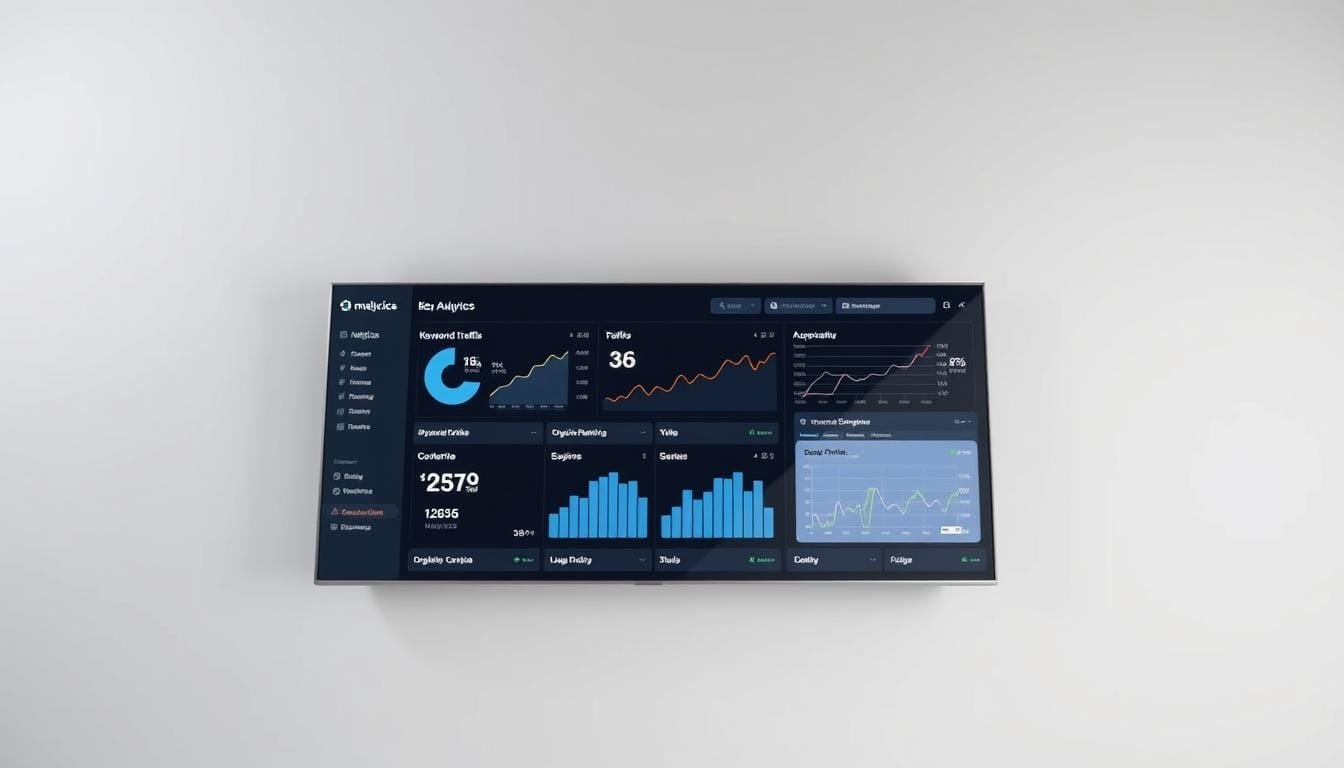Did you know a good keyword research plan can boost website traffic by up to 30%? This big increase comes from using SEO analytics and the right search volume tools.
For marketers, knowing the value of these tools is key in today’s digital world. Good SEO projects need data to guide their plans.
This article will explore search volume tools, their benefits, and types for marketers. By the end, you’ll know how to use these tools to improve your marketing.
The Critical Role of Search Volume in Digital Marketing

Search volume is key in digital marketing. It shows how popular certain keywords and topics are. This helps marketers plan their SEO and content better.
Defining Search Volume and Its SEO Impact
Search volume is how often a keyword or phrase is searched on Google. It’s essential for search engine optimization (SEO). It helps marketers find popular keywords, understand what users want, and make their content better.
By looking at search volume, marketers can boost their website’s visibility. For more tips on SEO, check out Bizansy. They offer advice on getting backlinks for authority.
How Search Volume Data Drives Marketing Decisions
Search volume data shapes marketing choices. It reveals trending topics and what consumers are interested in. This helps marketers create focused campaigns.
By studying search volume trends, marketers can spot future chances and hurdles. This lets them stay competitive. Using data to guide decisions helps marketers improve their strategies and increase their return on investment.
Essential Search Volume Tools for Modern Marketers

In today’s digital world, knowing search volume is key for marketers. It helps them improve their online presence. Analyzing search volume data can greatly affect a marketing strategy’s success.
Why Every Marketer Needs Search Volume Analysis
Search volume analysis is essential for marketers to stay ahead. It lets them understand what people are looking for. This way, they can create content and ads that meet demand, boosting their visibility and chances of success.
Keyword research tools are central to this analysis. They offer insights into what consumers want and like.
Also, search volume data shows trends and patterns. This helps marketers make smart choices about their strategies. It’s about using data to guide decisions, not just reacting to trends.
Key Features to Look for in Search Volume Tools
When picking a search volume tool, look for certain features. First, the data must be accurate and up-to-date. It should cover a wide range of keywords and searches.
Another important feature is analyzing competitors’ strategies. This gives you an edge. The tool should also be easy to use, with a simple interface.
Being able to integrate with other marketing tools is also key. This makes the tool more useful and versatile.
How Bizansy Helps Marketers Evaluate Search Volume Tools
Bizansy is vital for marketers to find the right search volume tools. It offers expert analysis and comparisons of SEO tools. This helps marketers choose the best tool for their needs.
With detailed reviews and insights, Bizansy highlights the good and bad of different tools. This ensures marketers can use the right tool to enhance their marketing efforts.
Understanding Search Volume Metrics and KPIs

Marketers need to know about search volume metrics and KPIs to improve their digital marketing. These tools show how people use search engines. This helps marketers make their content and ads better.
Monthly Search Volume vs. Annual Trends
It’s key to know the difference between monthly and annual search trends. Monthly trends show what’s happening now. Annual trends show how things change over time. This helps marketers plan better, catching high points and avoiding lows.
Keyword Difficulty and Competition Scores
Keyword difficulty and competition scores are important. They tell marketers if a keyword is worth aiming for. A keyword difficulty tool looks at backlinks, content quality, and competition. This score helps decide if a keyword is too hard to get.
Click-Through Rate Predictions
Click-through rate (CTR) predictions are also key. They show how likely people are to click on content in search results. Knowing this helps improve meta titles, descriptions, and content to get more clicks.
Search Volume Seasonality Analysis
Seasonality analysis looks at how search trends change throughout the year. It helps marketers get ready for changes in search traffic. By knowing these trends, marketers can make their content and ads more relevant.
Understanding these metrics and KPIs helps marketers improve their digital marketing. They can increase their online presence and attract more targeted traffic to their sites.
Free Search Volume Tools Worth Exploring

Free search volume tools are great for boosting SEO without spending a lot. They help marketers understand search trends and improve their content.
Google Keyword Planner
Google Keyword Planner is a top choice for keyword research. It shows search volume and trends.
Setup and Configuration
To start with Google Keyword Planner, you need a Google Ads account. You link your Ads account to the Keyword Planner and set your search preferences.
Limitations and Workarounds
It needs a Google Ads account. But, it’s good for finding keywords and planning content.
Best Practices for Marketers
Marketers should find high-volume keywords with Google Keyword Planner. Then, they should update their content strategy often.
Ubersuggest’s Free Tier
Ubersuggest has a free version that gives keyword suggestions and search volume data. It’s great for expanding your keyword list.
Key Features:
- Keyword suggestions based on seed keywords
- Search volume data for keyword planning
- Content ideas based on trending topics
Wordtracker Scout and Alternative Free Options
Wordtracker Scout gives insights into keyword performance. Marketers can also check out Keyword Tool and AnswerThePublic for free.
“Using the right keyword research tools can significantly improve your SEO strategy.” –
These tools offer valuable data. They help marketers make their content better and rank higher in search engines.
Premium Search Volume Tools and Their ROI

Investing in premium search volume tools can greatly improve a marketer’s ROI. These tools help refine keyword strategies, outmaneuver competitors, and boost returns.
SEMrush Keyword Magic Tool
The SEMrush Keyword Magic Tool is a top choice for finding high-potential keywords. It’s known for its:
Advanced Filtering Capabilities
Marketers can filter keywords by various criteria. This helps focus on the most relevant and high-volume searches. This is key for creating campaigns that hit the mark with the audience.
Competitive Analysis Features
Knowing what competitors do is essential to stay ahead. The SEMrush Keyword Magic Tool offers insights into competitor strategies. This info is priceless for creating a unique selling point.
Integration with Other SEMrush Tools
It integrates well with other SEMrush tools. This makes the Keyword Magic Tool a core part of a marketer’s toolkit.
“SEMrush has been a game-changer for our keyword strategy, providing us with the insights we need to stay competitive.” – Marketing Expert
Ahrefs Keywords Explorer
Ahrefs Keywords Explorer is a top tool for keyword research. It has a vast database of keywords with search volume and difficulty metrics. Marketers can use this to focus on the best keywords.
Moz Keyword Explorer and Pro Suite
Moz Keyword Explorer is great for finding relevant keywords and understanding SERP competition. It’s part of the Moz Pro Suite, which offers a complete SEO solution. Moz’s combination of keyword research and SEO tools is very valuable for marketers.
Using these premium tools can greatly improve a marketer’s ROI. The right tool should fit their needs and be part of their marketing strategy.
Specialized Search Volume Tools for Different Platforms

Different digital platforms have led to a need for specific search volume tools. Marketers need to know how people search on each platform. This knowledge is key for improving their strategies.
Amazon Keyword Research Tools
Amazon Keyword Research Tools are a must for e-commerce sites. They help sellers improve their product listings to show up more in Amazon searches. Tools like Jungle Scout and Helium 10 give insights into Amazon’s search trends. This helps sellers make smart decisions.
YouTube Search Volume Analysis
YouTube is huge for video creators. YouTube Search Volume Analysis tools help them make their videos more visible. By knowing what keywords are popular, creators can make videos that people want to watch. Tools like TubeBuddy and VidIQ give creators the data they need.
Social Media Keyword Volume Tools
Social media sites like Facebook and Twitter have their own search patterns. Social Media Keyword Volume Tools show what content is popular and what keywords people use. This helps businesses create content that interests their audience. Tools like Hootsuite Insights and Sprout Social offer insights into social media trends.
In summary, specialized search volume tools are essential for marketers. They help businesses understand how people search on Amazon, YouTube, and social media. This knowledge leads to more effective marketing campaigns.
Local SEO and Geo-Targeted Search Volume Analysis

Geo-targeted search volume analysis is a big deal for marketers. It helps them focus on specific areas. Knowing how to use local SEO can really boost a business’s online presence.
Tools for Local Search Volume Research
There are many tools for local search volume research. Google Keyword Planner, Ahrefs, and SEMrush are some of them. They give insights into how people search for things in certain places.
- Google Keyword Planner: Offers location-specific data and is ideal for identifying relevant keywords.
- Ahrefs: Provides detailed keyword data, including search volume and competitor analysis.
- SEMrush: Includes tools for technical SEO audits and competitor analysis, useful for local SEO strategies.
Regional Search Trends and Variations
Search trends vary by region, influenced by culture, economy, and seasons. It’s key to grasp these differences for good local SEO.
For example, winter clothing sales might rise in cold areas during winter. Swimwear sales might increase in coastal areas during summer.
Mobile vs. Desktop Search Volume Differences
Mobile search has changed how we use search engines, more so for local searches. Knowing the mobile vs. desktop search volume differences is vital for local SEO.
Mobile users often search for “near me” or “open now.” This shows the need for businesses to focus on voice search and local intent.
To improve your local SEO, look at competitor keyword gaps and emerging trends. For more on optimizing your marketing funnel, see our comparison of DropFunnels vs. ClickFunnels.
Implementing Search Volume Data in Your Content Strategy

A good content strategy starts with knowing what people search for. This knowledge helps you create content that meets their needs. It also boosts your online presence.
Creating Content Calendars Based on Search Volume
Using search volume data to plan your content is smart. Start by finding out what keywords are popular. Tools like Google Keyword Planner or SEMrush can help you find trending topics.
To make your content calendar work best, follow these steps:
- Find keywords that are searched a lot in your field.
- Plan your content around these keywords, making sure they fit naturally.
- Use a mix of popular and long-tail keywords to reach different types of searches.
Balancing High-Volume and Long-Tail Keywords
It’s important to mix high-volume and long-tail keywords in your strategy. High-volume keywords bring a lot of traffic but are very competitive. Long-tail keywords have lower search numbers but are more specific and easier to rank for.
For example, a company selling outdoor gear might aim for “hiking boots” but also create content for “waterproof hiking boots for women.” This way, you attract both general and specific search traffic.
“The key to a successful content strategy is not just to focus on high-volume keywords, but to understand the intent behind the searches and create content that meets those needs.”
Measuring Content Performance Against Search Volume
To see if your content is working, track its performance against search volume. Look at organic traffic, click-through rates, and conversion rates for your keywords.
By checking these numbers, you can improve your strategy. Adjust your keywords and content types to better match what your audience is looking for.
Common Pitfalls When Using Search Volume Tools

Marketers using search volume tools must watch out for common pitfalls to get the most out of their efforts. These tools can be less useful if key factors are ignored. Knowing these mistakes can help marketers improve their strategies and get better results.
Overreliance on Volume Without Context
Just looking at search volume without thinking about the context can lead to bad marketing choices. For example, a keyword might have lots of searches, but if it doesn’t match your audience, it’s not useful. Understanding the context is essential to use search volume data well. Tools like YouTube analysis tools can give more insights into how your audience interacts with your content.
Ignoring Search Intent Behind the Numbers
Search intent is often overlooked but is very important. Knowing why people search for certain keywords helps create better content. If you ignore search intent, your content might not connect with your audience. By looking at search intent, you can make your content more relevant, which can boost engagement.
Failing to Account for Keyword Cannibalization
Keyword cannibalization happens when different pages on a site target the same keyword, making them compete. This can weaken each page’s ranking. To avoid this, marketers should do thorough keyword research and make sure their content strategy doesn’t lead to cannibalization. This way, they can improve their site’s overall ranking.
Advanced Search Volume Analysis Techniques
To stay ahead in the digital world, marketers need advanced search volume analysis. These methods help find hidden chances, beat competitors, and boost conversions. By digging into search data, marketers can sharpen their SEO plans and get more online visibility.
Competitor Keyword Gap Analysis
Competitor keyword gap analysis is a key technique. It finds keywords your site isn’t using but your rivals are. By looking at these keywords’ search volume, you can pick which to aim for. Bizansy’s competitor analysis can show you these gaps for a better SEO plan.
To do a competitor keyword gap analysis, list your rivals and use SEO tools to check their keywords. Then, compare their lists to yours to find gaps. Choose keywords with lots of searches that fit your business. Targeting these can bring more visitors and help you beat rivals.
Identifying Emerging Trends Before They Peak
Spotting trends early is another advanced method. It means looking at search data to find new trends early. This way, you can make content about these trends before they’re popular, giving you an edge. Google Trends and keyword tools can help find these trends.
To spot trends early, keep an eye on search data often. Look for keywords that are getting more popular but haven’t hit their peak yet. Making content about these keywords can help you reach early adopters and show you’re a leader in your field.
Correlating Search Volume with Conversion
Linking search volume to conversion is key for good ROI. Just because a keyword is searched a lot doesn’t mean it leads to sales. Look at the conversion chance of keywords to focus on those that might bring in more business. This means checking click-through rates, competition, and what users want.
To link search volume to conversion, use SEO tools that show how keywords perform. Look at who’s competing for your keywords and what users want. Knowing this can help you make content that really speaks to your audience and gets results.
Industry-Specific Search Volume Strategies
To succeed in their markets, businesses need to use specific search volume strategies. It’s key to know the unique traits of their industry. This knowledge helps in creating effective search volume plans.
E-commerce Search Volume Optimization
E-commerce sites can boost their sales by optimizing listings and categories with search data. By finding high-volume keywords, they can make their products more visible. This leads to more sales. Here are some strategies:
- Do deep keyword research to find relevant search terms.
- Make product titles, descriptions, and meta tags keyword-rich.
- Use search data to guide inventory and product development.
B2B vs. B2C Search Volume Approaches
B2B and B2C businesses have different search volume strategies. B2B focuses on long-tail keywords for complex buying processes. B2C targets broader, more general terms. It’s vital to understand these differences for effective strategies.
B2B might use keywords like “enterprise software solutions.” B2C might use terms like “best smartphones.”
Niche Market Keyword Research Tactics
Niche markets need special keyword research to attract the right audience. By knowing their audience’s needs, businesses can find the right keywords. They can then create content that speaks to their audience.
Using long-tail keywords that are less competitive is effective. Also, tools that show niche-specific search trends are helpful.
The Future of Search Volume Tools and AI Integration
The world of search volume analysis is about to change a lot. This change comes from new artificial intelligence (AI) technology. AI is making search volume tools better and more useful.
Machine Learning in Search Volume Prediction
Machine learning is being added to search volume tools. This makes them better at predicting what will happen next. Machine learning helps these tools understand past data, find patterns, and make new predictions.
Voice Search Impact on Keyword Volume
Voice search is changing how we look at keywords. As more people use voice search, tools are getting better at understanding natural language. This gives a deeper look into how people search.
How Bizansy Tracks Emerging Search Volume Technologies
Bizansy is leading the way in tracking new search volume technologies. They keep an eye on AI and machine learning. This way, Bizansy helps marketers use the newest tools and strategies to improve their search plans.
Maximizing Your Marketing ROI with Strategic Search Volume Analysis
To boost marketing ROI, businesses need to use strategic search volume analysis. They must understand what people are searching for. This way, they can make campaigns that really work.
Tools like SEMrush and Ahrefs give insights into search trends and keywords. By using these tools, businesses can see where to focus their efforts. This helps them get more online visibility and better results.
Marketers should keep an eye on search data and change their strategies as needed. They should also make sure their content is high-quality and meets their audience’s needs. This approach helps them stay competitive and get the most out of their PPC ads.











